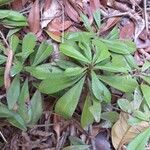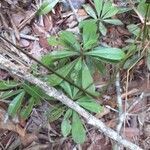Small much-branched evergreen tree or shrub, height up to 10 m.; bark grey with small longitudinal fissures.. Terminal buds, young shoots and very young leaves with dense ferrugineous pubescence, older leaves and branchlets glabrous.. Petioles 3–10(–12) mm. long, glabrous or puberulous.. Leaf-lamina coriaceous, narrowly to broadly obovate or rarely narrowly elliptic, up to 6.5 (rarely –9.5) cm. long and 2.6 (rarely –3.2) cm. wide; upper surface dark shiny green, lower surface paler green, sometimes with slight ferrugineous pubescence near base; nervation inconspicuous.. Flowers 2–6.. Pedicels 4–7 mm. long, ferrugineously pubescent.. Calyx-lobes connate near base; outer lobes ± ovate, 2.5–3.5 mm. long, 1.5–2 mm. wide, ferrugineously pubescent externally; inner lobes narrowly elliptic, 3–4 mm. long, 1–1.5 mm. wide, puberulous externally.. Corolla-tube up to 1 mm. long; lobes pale green, ± trifid; two outer segments ± lanceolate, 2.5–4 mm. long; median segment variable in shape, ± ligulate to narrowly elliptic, or rarely very small and subulate or absent, up to 4 mm. long.. Filaments 1.5–3 mm. long; anthers ± 1 mm. long.. Staminodes irregular in shape, ± triangular to oblong, very small, serrulate, denticulate or ± laciniate, usually with ± terminal acumen.. Ovary globose, ± 1 mm. long, densely ferrugineous pilose; style up to 3 mm. long.. Fruit greenish, ellipsoid to obovoid, up to 1 cm. long, 7 mm. in diameter, subglabrous, 1-seeded.. Seed obliquely ovoid, compressed, up to 8 mm. long, 5 mm. in diameter; scar lateral, extending to base.
More
A shrub or small tree. It grows 3-6 m tall. It can be 20 m tall. The bark is grey and cracked. The leaves are small and clustered towards the tips of the branches. They are usually less than 4 cm long. They are light green and shiny. The flowers are cream. The fruit is oval and can be up to 1.3 cm long. It is light green but turns more yellow as it ripens.



